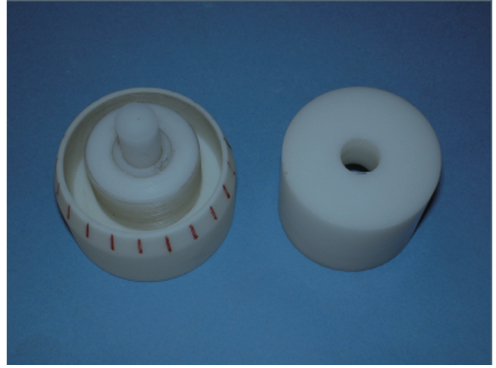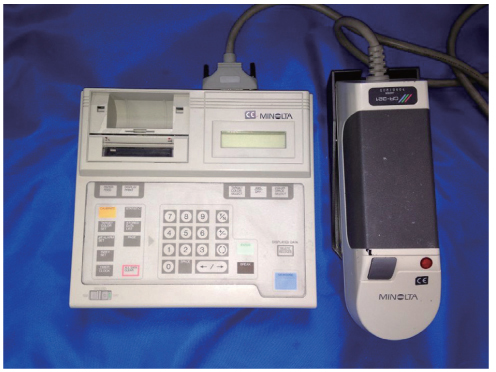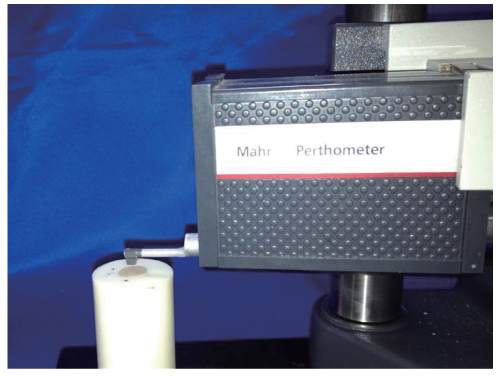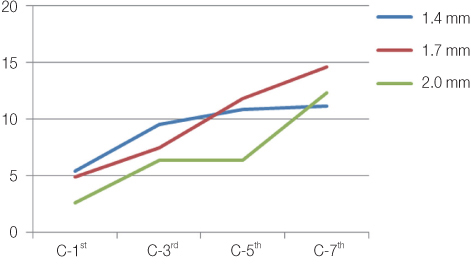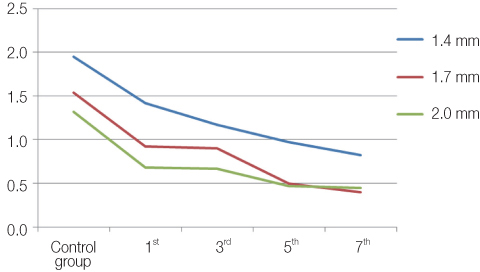J Adv Prosthodont.
2014 Aug;6(4):309-316. 10.4047/jap.2014.6.4.309.
The effect of repeated firings on the color change and surface roughness of dental ceramics
- Affiliations
-
- 1Department of Prosthodontics, Faculty of Dentistry, Ankara University, Ankara, Turkey. dt.fehmi@gmail.com
- 2Dental Clinic, Antalya, Turkey.
- KMID: 1974851
- DOI: http://doi.org/10.4047/jap.2014.6.4.309
Abstract
- PURPOSE
The color of the ceramic restorations is affected by various factors such as brand, thickness of the layered the ceramic, condensation techniques, smoothness of surface, number of firings, firing temperature and thickness of dentin. The aim of this study was to evaluate the color change and surface roughness in dental porcelain with different thicknesses during repeated firings.
MATERIALS AND METHODS
Disc-shaped (N=21) metal-ceramic samples (IPS Classic; Ivoclar Vivadent; Shaar, Liechtenstein) with different thickness were exposed to repeated firings. Color measurement of the samples was made using a colorimeter and profilometer was used to determine surface roughness. ANOVA and Tukey tests with repeated measurements were used for statistical analysis.
RESULTS
The total thickness of the ceramics which is less than 2 mm significantly have detrimental effect on the surface properties and color of porcelains during firings (P<.05).
CONCLUSION
Repeated firings have effects on the color change and surface roughness of the dental ceramics and should be avoided.
Figure
Reference
-
1. Seghi RR, Johnston WM, O'Brien WJ. Spectrophotometric analysis of color differences between porcelain systems. J Prosthet Dent. 1986; 56:35–40.2. O'Brien WJ, Kay KS, Boenke KM, Groh CL. Sources of color variation on firing porcelain. Dent Mater. 1991; 7:170–173.3. Hammad IA, Stein RS. A qualitative study for the bond and color of ceramometals. Part II. J Prosthet Dent. 1991; 65:169–179.4. Yilmaz K, Ozkan P. The methods for the generation of smoothness in dental ceramics. Compend Contin Educ Dent. 2010; 31:30–32. 3436–38. passim; quiz 42, 44.5. Jorgenson MW, Goodkind RJ. Spectrophotometric study of five porcelain shades relative to the dimensions of color, porcelain thickness, and repeated firings. J Prosthet Dent. 1979; 42:96–105.6. Barghi N, Lorenzana RE. Optimum thickness of opaque and body porcelain. J Prosthet Dent. 1982; 48:429–431.7. Jacobs SH, Goodacre CJ, Moore BK, Dykema RW. Effect of porcelain thickness and type of metal-ceramic alloy on color. J Prosthet Dent. 1987; 57:138–145.8. Shokry TE, Shen C, Elhosary MM, Elkhodary AM. Effect of core and veneer thicknesses on the color parameters of two all-ceramic systems. J Prosthet Dent. 2006; 95:124–129.9. Douglas RD, Przybylska M. Predicting porcelain thickness required for dental shade matches. J Prosthet Dent. 1999; 82:143–149.10. Antonson SA, Anusavice KJ. Contrast ratio of veneering and core ceramics as a function of thickness. Int J Prosthodont. 2001; 14:316–320.11. Lee YK, Lim BS, Kim CW. Effect of surface conditions on the color of dental resin composites. J Biomed Mater Res. 2002; 63:657–663.12. Barghi N, Goldberg . Porcelain shade stability after repeated firing. J Prosthet Dent. 1977; 37:173–175.13. Barghi N, Richardson JT. A study of various factors influencing shade of bonded porcelain. J Prosthet Dent. 1978; 39:282–284.14. Uludag B, Usumez A, Sahin V, Eser K, Ercoban E. The effect of ceramic thickness and number of firings on the color of ceramic systems: an in vitro study. J Prosthet Dent. 2007; 97:25–31.15. Ozturk O, Uludag B, Usumez A, Sahin V, Celik G. The effect of ceramic thickness and number of firings on the color of two all-ceramic systems. J Prosthet Dent. 2008; 100:99–106.16. Brewer JD, Akers CK, Garlapo DA, Sorensen SE. Spectrometric analysis of the influence of metal substrates on the color of metal-ceramic restorations. J Dent Res. 1985; 64:74–77.17. Crispin BJ, Seghi RR, Globe H. Effect of different metal ceramic alloys on the color of opaque and dentin porcelain. J Prosthet Dent. 1991; 65:351–356.18. van der Burgt TP, ten Bosch JJ, Borsboom PC, Kortsmit WJ. A comparison of new and conventional methods for quantification of tooth color. J Prosthet Dent. 1990; 63:155–162.19. CIE (Commission Internationale de Eclairage). Colorimetry. CIE Publication No. 15.2. 3rd ed. Vienna: Bureau Central de la CIE;2004.20. Johnston WM, Kao EC. Assessment of appearance match by visual observation and clinical colorimetry. J Dent Res. 1989; 68:819–822.21. Ruyter IE, Nilner K, Moller B. Color stability of dental composite resin materials for crown and bridge veneers. Dent Mater. 1987; 3:246–251.22. Berns RS, Billmeyer FW, Saltzman M, Billmeyer FW. Billmeyer and Saltzman's principles of color technology. 3rd ed. New York: Wiley;2000. p. 71–74.23. Bolt RA, Bosch JJ, Coops JC. Influence of window size in small-window colour measurement, particularly of teeth. Phys Med Biol. 1994; 39:1133–1142.24. Bessing C, Wiktorsson A. Comparison of two different methods of polishing porcelain. Scand J Dent Res. 1983; 91:482–487.25. al-Hiyasat AS, Saunders WP, Sharkey SW, Smith GM, Gilmour WH. The abrasive effect of glazed, unglazed, and polished porcelain on the wear of human enamel, and the influence of carbonated soft drinks on the rate of wear. Int J Prosthodont. 1997; 10:269–282.26. Sasahara RM, Ribeiro Fda C, Cesar PF, Yoshimura HN. Influence of the finishing technique on surface roughness of dental porcelains with different microstructures. Oper Dent. 2006; 31:577–583.27. Clayton JA, Green E. Roughness of pontic materials and dental plaque. J Prosthet Dent. 1970; 23:407–411.28. Kawai K, Urano M, Ebisu S. Effect of surface roughness of porcelain on adhesion of bacteria and their synthesizing glucans. J Prosthet Dent. 2000; 83:664–667.29. Martínez-Gomis J, Bizar J, Anglada JM, Samsó J, Peraire M. Comparative evaluation of four finishing systems on one ceramic surface. Int J Prosthodont. 2003; 16:74–77.30. Brewer JD, Garlapo DA, Chipps EA, Tedesco LA. Clinical discrimination between autoglazed and polished porcelain surfaces. J Prosthet Dent. 1990; 64:631–634.31. Cook PA, Griswold WH, Post AC. The effect of superficial colorant and glaze on the surface texture of vacuum-fired porcelain. J Prosthet Dent. 1984; 51:476–484.32. McLean JW, Hubbard JR, Kedge MI. The science and art of dental ceramics. Volume 1: The nature of dental ceramics and their clinical use. Chicago: Quintessence Pub. Co.;1979.33. Sahin V, Uludag B, Usumez A, Ozkir SE. The effect of repeated firings on the color of an alumina ceramic system with two different veneering porcelain shades. J Prosthet Dent. 2010; 104:372–378.34. Knispel G. Factors affecting the process of color matching restorative materials to natural teeth. Quintessence Int. 1991; 22:525–531.35. Crispin BJ, Seghi RR, Globe H. Effect of different metal ceramic alloys on the color of opaque and dentin porcelain. J Prosthet Dent. 1991; 65:351–356.36. Lund PS, Piotrowski TJ. Color changes of porcelain surface colorants resulting from firing. Int J Prosthodont. 1992; 5:22–27.37. Mulla FA, Weiner S. Effects of temperature on color stability of porcelain stains. J Prosthet Dent. 1991; 65:507–512.38. Cubas GB, Camacho GB, Fontes ST, Pereira-Cenci T. The effect of repeated firings on the color of feldspathic ceramics. Gen Dent. 2011; 59:e116–e120.39. Yilmaz B, Ozçelik TB, Wee AG. Effect of repeated firings on the color of opaque porcelain applied on different dental alloys. J Prosthet Dent. 2009; 101:395–404.40. Barghi N. Color and glaze: effects of repeated firings. J Prosthet Dent. 1982; 47:393–395.41. Mackert JR Jr, Williams AL. Microcracks in dental porcelain and their behavior during multiple firing. J Dent Res. 1996; 75:1484–1490.42. Yilmaz K, Ozkan P. Profilometer evaluation of the effect of various polishing methods on the surface roughness in dental ceramics of different structures subjected to repeated firings. Quintessence Int. 2010; 41:e125–e131.43. Jalali H, Alizadeh ES, Sadighpour L, Shabestari GO, Fard MJ. The effect of background and ceramic thickness on the color of an all-ceramic restorative system. J Calif Dent Assoc. 2010; 38:179–186.44. Antonson SA, Anusavice KJ. Contrast ratio of veneering and core ceramics as a function of thickness. Int J Prosthodont. 2001; 14:316–320.45. Dozić A, Kleverlaan CJ, Meegdes M, van der Zel J, Feilzer AJ. The influence of porcelain layer thickness on the final shade of ceramic restorations. J Prosthet Dent. 2003; 90:563–570.
- Full Text Links
- Actions
-
Cited
- CITED
-
- Close
- Share
- Similar articles
-
- The effect of repeated firings on the color change of dental ceramics using different glazing methods
- The effect of repeated firings on the color of zirconia-based all-ceramic system
- The effect of ceramic thickness and number of firings on the color of a zirconium oxide based all ceramic system fabricated using CAD/CAM technology
- Influence of polishing systems on roughness and color change of two dental ceramics
- Mechanical properties of zirconia after different surface treatments and repeated firings


